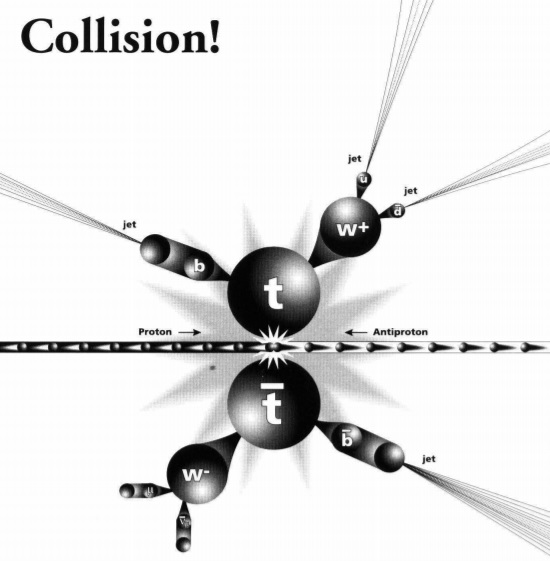Is it the Top Quark? Yes!!!
Physicists at Fermilab today announced the discovery of a subatomic particle known as the top quark, the last undiscovered quark of the six predicted to exist by current scientific theory. Scientists worldwide had sought the top quark since the discovery of the bottom quark at Fermilab in 1977.
Two research papers, submitted simultaneously on Friday, February 24, to Physical Review Letters by the CDF and DZero experiment collaborations respectively, describe the observation of top quarks produced in high-energy collisions between protons and antiprotons, their antimatter counterparts, at Fermilab's Tevatron, the world's highest energy particle accelerator. The collaborations, each with about 450 members, will present their results at seminars held at Fermilab today.
"Last April, CDF announced the first direct experimental evidence for the top quark," said William Carithers, Jr., cospokesman for the CDF experiment, "but at that time we stopped short of claiming a discovery. Now, the analysis of about three times as much data confirms our previous evidence and establishes the discovery of the top quark."
The DZero collaboration has discovered the top quark in an independent investigation. "The DZero observation of the top quark depends primarily on the number of events we have seen but also on their characteristics," said Paul Grannis, DZero cospokesman. "Last year, we did not have enough events to make a statement about the top quark's existence, but now the signal is clear."
Both collaborations have strong international participation. Experimenters from Brazil, Canada, Colombia, France, India, Italy, Japan, Korea, Mexico, Poland, Russia and Taiwan joined U.S. scientists in the search for the top quark.
"The discovery of the top quark is a great achievement for the collaborations," said Fermilab Director John Peoples, "and also for the men and women of Fermilab who imagined, then built, and now operate the Tevatron accelerator. We have much to learn about the top quark and the nature of matter in the decade ahead. We look forward to the next phase of research with this extraordinary accelerator, the most powerful tool on earth for precisely characterizing the deep substructure of matter."
How Do We Know It's a Top Quark?
Physicists recognize the particles produced in proton-antiproton collisions by their electronic signatures, shown graphically by computers. In the "legoplot" below, the height of each lego tower shows the amount of energy detected in each cell of a detector's calorimeter after a particle collision like the one illustrated.
How can we recognize a top quark's electronic signature? Top quarks exist for such a short time that we don't actually find their signatures, but instead those of their known decay products. Here, the lego plot shows one characteristic signature pattern-called a "lepton plus jet event"-that we expect to see in a collision that produces a top-antitop quark pair. The top quarks instantly decay into two W particles and two b quarks. One W in turn decays into a muon and a neutrino, the other into up and down quarks. The up and down immediately decay into jets of particles. The b quarks travel a little way before they decay into jets.
The results of this collision are a muon, a neutrino and four jets of particles. The lego plot identifies the muon and the four jets. The neutrino leaves no tracks; we infer its existence from missing energy in the collision results.




